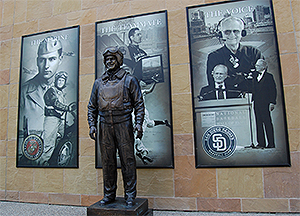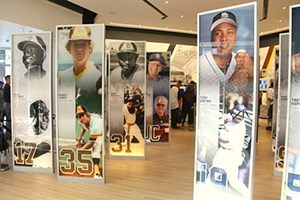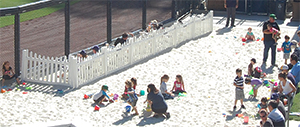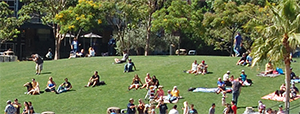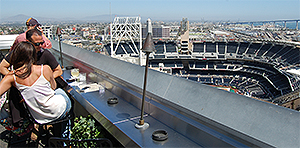THE BALLPARKS
Petco Park
San Diego, California
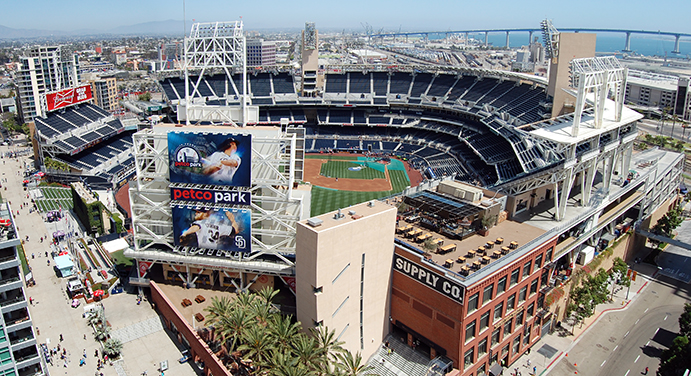
The city gave the Padres a Quarter, and the Padres gave back something priceless. Petco Park is the perfect ballpark for the perfect climate, a verdant place where laid-back San Diegans can break out the picnic blanket, unfold the beach chair or grab a stool atop a historic landmark before taking a leisurely stroll to adjacent streets lined with gaslamps, restaurants and bars to wash away the latest 1-0 result.
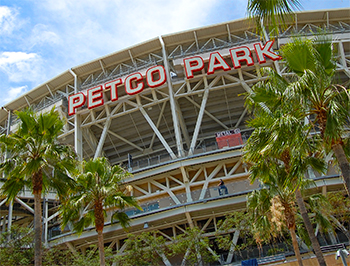 When you approach Petco Park, the one thing you’ll feel the least is heightened blood pressure. Maybe it’s the infallible weather, with its endless mild conditions, gentle breezes filing off the bay and a brand of overcast that’s remarkably refreshing. Maybe it’s the scenery dotted with yachts, palm trees, open architecture and trimmed green grass that looks too good to be true. Or maybe it’s just the locals, kicking back and smiling as they always have in San Diego. All you’re hoping is that stepping into Petco Park won’t screw up the bliss.
When you approach Petco Park, the one thing you’ll feel the least is heightened blood pressure. Maybe it’s the infallible weather, with its endless mild conditions, gentle breezes filing off the bay and a brand of overcast that’s remarkably refreshing. Maybe it’s the scenery dotted with yachts, palm trees, open architecture and trimmed green grass that looks too good to be true. Or maybe it’s just the locals, kicking back and smiling as they always have in San Diego. All you’re hoping is that stepping into Petco Park won’t screw up the bliss.
Petco Park will offer no such disappointment. It serves to enhance the primo ‘tude, drawing thumbs and pinkies up from the locals who find it bitchin’ over bummer. Perhaps the San Diego Padres feel disconcerted over the lack of intensity from the crowds, but what else would you expect from fans distracted from all that their ballpark has to offer?
Petco Park’s diversity of environments leaves spectators having to remind themselves that they’re not elsewhere in San Diego. The tree-lined Park at the Park, a rolling grassy plain behind the bleachers and surrounded by historic buildings and rising condo developments, could be mistaken for Balboa Park. The kids making sand castles behind the center-field fence feel just as content as they would on the shores of Coronado Beach. A walk through the field-level concourse conjures up visions of beachside cliffs and local naval shipyards. Petco Park is more than just a jewel on the edge of downtown San Diego. It is San Diego.
The Mission Valley Blues.
When software entrepreneur John Moores bought the Padres in 1994 for $95 million, he saw the future of baseball in the form of revenue-rich retro ballparks and knew that Jack Murphy Stadium, the team’s home since its 1969 inception, wasn’t going to be a part of it. The Padres had been content at the city-built, city-owned venue to that point, but in 1997 it got expanded to 70,000 seats to better San Diego’s chances of hosting a Super Bowl. Oh, and another thing: All the revenue from 113 luxury suites inside the stadium? The football Chargers would now lay claim to it. Almost overnight, the Padres lost both intimacy and profitability in their original home.
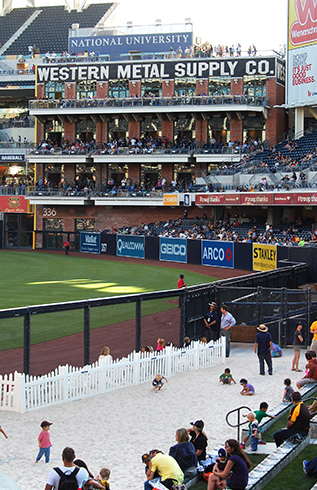
Petco Park’s two best-known attractions in one view: The Beachers in the foreground, the Western Metal Supply Co. building in the back.
Moores reminded San Diego politicians that he wasn’t afraid to pack up and move completely out of town if he didn’t get his new ballpark. But where? St. Petersburg, just granted an expansion team, was no longer in play as leverage for major league owners. Mexico City was rumored, as was the Washington D.C. area—a sick joke of sorts, given that 20 years earlier the Padres had all but locked up the moving vans and were ready to turn the ignition key when Ray Kroc came to the rescue, bought the team and kept it from moving to the Nation’s Capitol.
Unwilling to turn deaf to Moores’ threats, San Diego acquiesced, formed a ballpark committee and began the process of where a new venue could be placed. It looked inland at Mission Valley, next to Jack Murphy (now Qualcomm) Stadium; it looked southward to suburban Chula Vista, which offered bayfront property amid unromantic surroundings; and it looked at two sites downtown, the preferable option for Moores. The committee ultimately agreed; it was now up to the voters to agree with them.
Serendipitously, the ballpark campaign in 1998 ran simultaneous to the Padres’ second National League pennant in 30 years, which was bound to influence the vote. That the Padres were swept in the World Series by the New York Yankees didn’t seem to dull the momentum—after all, there was no shame to be found in getting their butts kicked by a 114-48 Yankees team heralded as one of the greatest ever. The Padres outspent bare-bones opposition forces by 100-1, but with a close call anticipated and Moores losing sleep over a possible defeat, he made a new threat: Vote for the ballpark, or he’d dismantle the pennant-winning roster just as Wayne Huizenga had done a year earlier in Florida with the world champion Marlins.
The measure won. Easily. The 60-40 split allowed Moores to keep one promise by not moving the Padres. He broke another: In the wake of the successful vote, Moores tore the team apart anyway. Gone after 1998 was pitching ace Kevin Brown, 50-homer man Greg Vaughn, 13-game winner Joey Hamilton and offensive stalwarts Steve Finley and Ken Caminiti—many of the horses who brought the Padres to the brink of their first world title. Not surprisingly, the 1999 Padres sank without them—from 98 wins to 74, finishing two games out of the NL West cellar.
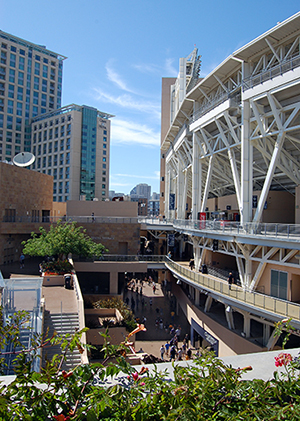
The canyon effect on the first-base side of Petco Park, created by multiple concourses separating the ballpark bowl from the outer sandstone structures. Towering in the background at left is the Omni Hotel, part of Petco Park’s extended development.
The performance on the field wasn’t the only thing souring the Padres in 1999. The anti-ballpark minority went on the warpath to overcome defeat via the legal system with 17 different lawsuits; most of them would eventually be brushed aside with little headache. But then a more ominous threat arose—from within. San Diego city councilwoman Valerie Stallings, a huge Padres fan and novice player on the stock market, suddenly decided to pour $5,000 into Neon Systems, a Houston-based software company; a month later—on the day she and the council voted unanimously to okay the ballpark’s financing—she cashed in and profited handsomely on her investment. There was only one problem; Neon was owned by John Moores.
Stallings’ $7,600 stock profit ultimately cost the Padres millions; that was the price of ballpark construction grinding to a halt for four months as a grand jury investigated whether a conflict of interest had played an unfair role in getting the project off and running. In addition to the suspicious stock bonanza, other revelations arose of Stallings receiving gifts from Moores—and rumors of Moores receiving inside information on the ballpark’s financial terms from Stallings. At first, Stallings stood her ground while Moores refused public comment on the matter; at the ballpark site, time stood still as steel columns rose naked from the ground with rebar spitting out the top like petrified spaghetti; a wooden sign at the base of one of the columns contained handwriting that said: “Stallings resign.” Four months later, she would; reporters went to her house for comment, for which she gave none. She was, however, wearing a lovely sweatshirt with Tony Gwynn’s image emblazoned upon it.
This whole mess delayed construction by over a year and pushed back the opening of the ballpark to 2004. It also shot up the budget $62 million from the original $411 million—but the Padres, financially hemorrhaging at Qualcomm Stadium, couldn’t afford to wait any further and picked up the tab. They would eventually make up most of that money when they signed a 22-year, $60 million deal with pet food chain Petco that finally gave the ballpark an official name: Petco Park.

In stark contrast to the first-base side of Petco Park, the lower concourse along the third-base line is more traditional, spacious and has the look and feel of a naval shipyard.
The Odd Couple.
Esteemed HOK Sport architect Joe Spear—the man behind the bulk of the new major league ballparks—was selected to design Petco Park, but the Padres decided to give him a partner. Antoine Predock, a renowned Southwestern architect whose modern, decidedly rectilinear work came off as a cross between Frank Lloyd Wright and Minecraft, was chosen because he didn’t have experience designing sports facilities and thus was viewed as one who could give Petco Park’s design an original and fresh perspective. Thinking out of his box, Predock’s first take was indeed different—drawing up a ballpark structure shaped like a volcano with surrounding buildings molded from faux lava rock. Spear all but laughed out loud, but he also knew that this one-of-a-kind assignment held the promise for something truly unique once he and Predock got into sync.
Mount Predock didn’t make the final cut, nor did early tower designs that were to evoke the area’s Spanish-era missions. What did evolve through the unlikely union of Spear and Predock was a dissimilar mix of architectural styles that paid tribute to the natural, established and historical aspects of the San Diego area.
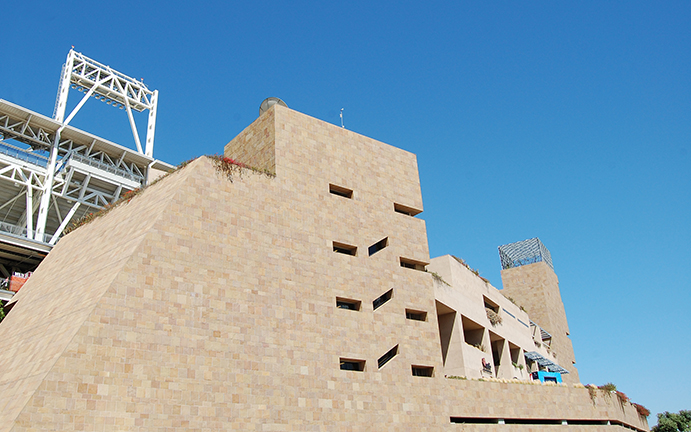
Like a fortress, an outer assemblage of buildings architecturally unrelated to Petco Park’s main bowl seems to protect the ballpark; it actually houses numerous high-end concessions and the Padres’ front offices.
Walking to the formal entrance on the south, home plate end of Petco Park, one finds the main ballpark structure all but protected by a series of outer buildings bearing the trademark Predock style of block-like towers that occasionally slice away diagonally and are virtually windowless save for strategically placed slats; if leaves you to wonder if you’re walking into a ballpark or a fortress. The outer structures are, in fact, meant to match the cliffs of nearby Torrey Pines—not so much in natural shapes but in natural hues, as the design team searched far and wide to find sandstone of similar color and finally found it in India.
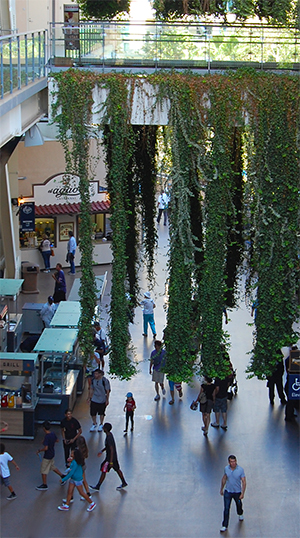
Long vines overflow from upper planter boxes and gently sway over Petco Park’s lower concourse, adding to the ballpark’s verdant nature.
The separation of the outer buildings from the ballpark bowl creates a lush canyon along the concourses on the first base side; gentle breezes sway long vines drooping from bridges above that connect second- and third-deck fans to concessionaires detached from the action. In creating this atmosphere, Petco Park has intentionally sacrificed visibility for aesthetics, not allowing fans to view the game from the whole of the concourse as is demanded at so many other new ballparks. Still, the Padres are sensitive to those who prefer not to miss a pitch; monitors are everywhere, the local radio play-by-play is echoing throughout, and there’s even mini scoreboards greeting spectators along the first level as they approach the aisles back to their seats.
Aye-Aye Candy.
The more traditional concourses on the third base side reveal something completely different: Wider and more airy spaces dominated by a maze of white steel beams fastened by rows of bolts reminiscent of a Navy vessel interior. The naval theme takes on a more literal existence within the concourse behind the right field bleachers, a virtual museum that includes a 20-foot scale model of the USS Midway and a sculptured tribute to former Padres manager/broadcaster Jerry Coleman, who fought in both World War II and the Korean War as a Marine air pilot. It’s bound to warm the hearts of uniformed Marine recruits who break from the rigors of boot camp, visit Petco Park every Sunday when the Padres are home and, in the middle of the fourth inning, are serenaded by the team and fans with a playing of the Marines’ Hymn.
Whereas most of the concourse character is hidden away from TV viewers, the Western Metal Supply Company building is in prime-time focus. It’s Petco Park’s signature element, a reminder of the ancient days of a more ruffian downtown San Diego when only off-duty sailors dared to tread. At first, the four-story, century-old brick building wasn’t even part of Petco Park’s plans; it was to be torn down along with a host of other derelict structures to make way for upscale living, retail and business in the name of gentrification. But not only has the Western Metal building been spared from the wrecking ball, it’s become retrofitted for renewal and outfitted to party from top to bottom.
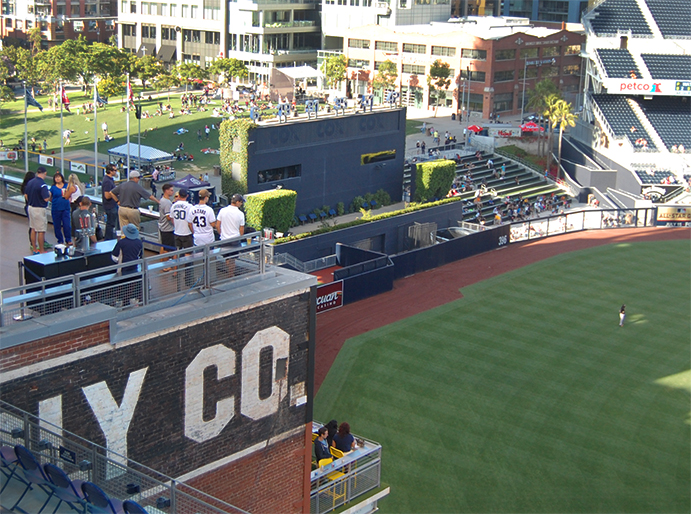
Fans enjoy the scene atop the Western Metals building, originally targeted for demolition before the Padres and Petco Park’s architects developed a fortuitous change of heart.
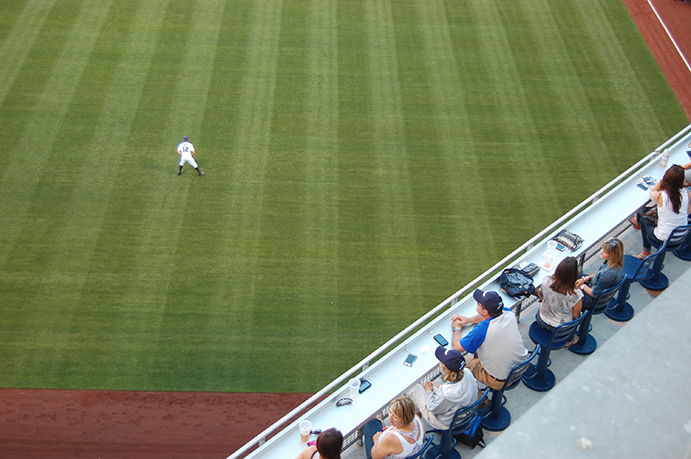
One floor down from the top of the Western Metals building is the Hall of Fame Bar & Grill, which includes a balcony for fans to sit, sip and enjoy the game high above the left-field corner.
Floor One is home to the Padres’ main gift store, a magnet attraction for the many entering from the nearby left-field gate; Floors Two and Three are occupied by suites that look straight down upon the left-field corner; Floor Four contains the Hall of Fame Bar & Grill, a spacious eatery that doesn’t owe its name to the offerings of sausage, sushi and nachos but, instead, the still-life locker displays of past Padres greats like Tony Gwynn, Dave Winfield and Randy Jones. The top of the building, seamlessly connected to the upper level concourse, is a terrace that once featured hi-rise bleacher stands but now is standing room for folks enjoying a party atmosphere courtesy of Rimel’s Rotisserie, which cranks out delicious chicken fare.
Petco Park’s other notable attraction can be found behind the center-field fence. Nestled between the ivy-strewn hitter’s backdrop and the double-decked right-field bleachers are the “Beachers,” a modest expanse of sand equipped with beach buckets, beach shovels and beach chairs, all backed by 14 concrete rows spaciously separated by a grass base for fans to easily stretch their legs. Naturally, the sand is a magnet for the tots—and also, unfortunately, for the bigger guys who put the kids and sand castles at risk by tearing out of the Beachers to scrounge for the rare home run ball clearing the fence.
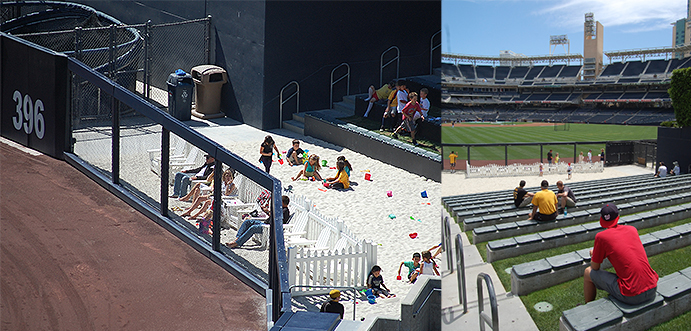
Not for kids only: The celebrated “Beachers” behind the center-field fence keep youngsters occupied with shovels and sand, while the parents and other adults enjoy laid-back seating in the form of beach chairs and spacious, grass-floored benches. (The Beachers were relegated away from the fence in 2016 in favor of a new lounge/bar area.)
The Beachers segue outward to the Park at the Park, a mildly hilly, grassy expanse that exists as a relaxed, inexpensive alternative for those used to taking advantage of local, easygoing open spaces such as the beaches or nearby Balboa Park. For many fans, this is the pregame meeting place within the ballpark as they flood in from the two corner outfield entrances; those who pay to sit on the grass are not restricted from the rest of the ballpark (they just can’t grab a seat), and although the hitter’s backdrop heavily obscures their view of the live action, they’re assisted by a big video screen behind the backdrop showing a local feed of the game. Here’s the cool part: The Park at the Park can be freely accessed when the ballpark isn’t being used.
Brother, Can You Spare a Hit?
The acid test to prove Petco Park’s readiness for the Padres and their fans came on March 31, 2004, when San Diego State beat the University of Houston, 4-0, in the ballpark’s first event. If the crowd of 40,106—the largest yet to see a college baseball game—believed that the low score had more to do with the younger kids trying and failing to muscle up in a big boys’ park, they would be sorely amiss.
The Padres and their opponents collectively hit .258 in Petco Park’s inaugural season. Though they didn’t know it at the time, the good news for the hitters was that the figure would represent the high-water mark at the ballpark for years to come. Petco Park played fair for sluggers down the left-field line (336 feet), right-field line (322) and even to the Beachers in straightaway center (396). But it was the outfield gaps—which stretched out to 402 feet—that left power hitters fuming as Petco Park quickly earned a reputation as an unquestioned pitcher’s park, the anti-Coors Field, where long fly balls destined to clear fences at other major league facilities went to die somewhere on Petco’s warning track.
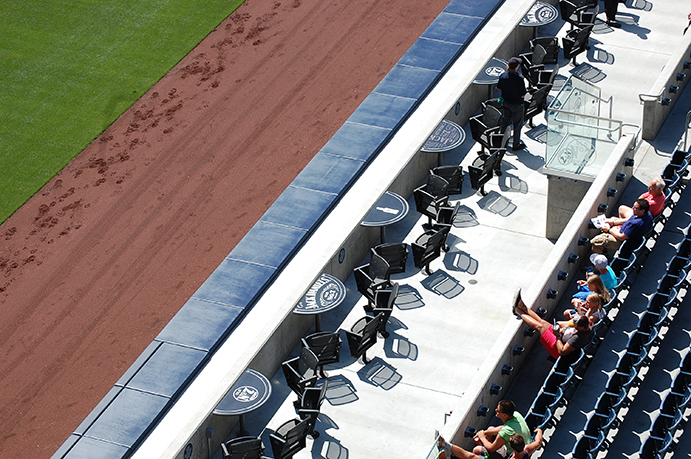
The Padres created Jack Daniel’s Old No. 7 Deck, a semi-private area of seating, after moving the right-field fences in to counter Petco Park’s reputation as death on hitters.
The uncozy confines were no accident. Padres general manager Kevin Towers bragged that he had made Petco “Barry Bonds-proof” after the future home run king had smashed 15 long balls over the wall in his last 82 at-bats at Qualcomm Stadium. Unfortunately for Towers, he also made it Ryan Klesko-proof, Phil Nevin-proof and Brian Giles-proof. These were the guys paid by the Padres to go deep often, and Petco Park wasn’t allowing them to do it. It took six games and 173 at-bats for the Padres to hit their first homer at the new ballpark; during this stretch, a livid Klesko threw an absolute fit in the dugout after what might have been a two-homer night at Qualcomm Stadium became a double and a long fly out at Petco. Later in May, Nevin—after reaching second from belting another Qualcomm homer-turned-Petco double—angrily gestured at Towers’ box; the two later engaged in a heated postgame argument in the clubhouse. Padres hitters became so publicly ticked off at Petco Park’s spacious outfields, then-manager Bruce Bochy forcibly slapped a gag order on the topic.
Through Petco Park’s first 10 seasons, there were 26 games that ended with a 1-0 score. Untold others finished at 2-1, 3-2 and 2-0. When the game trended away from the gratuitous hitting of the steroid era, offensive numbers only grew weaker at Petco Park; by 2011, batters hit an overall .227 there. The ballpark was in its ninth season when somebody finally hit three homers in a game—and it took a guy on steroids (Ryan Braun) to do it. It amazed those who thought a no-hitter would easily occur first at Petco; leave it to the Padres, the last major league team left to never throw a no-hitter, to mess up that forecast. Not even an opponent was able to go no-no until 2013, when San Francisco’s Tim Lincecum labored hard to earn one.
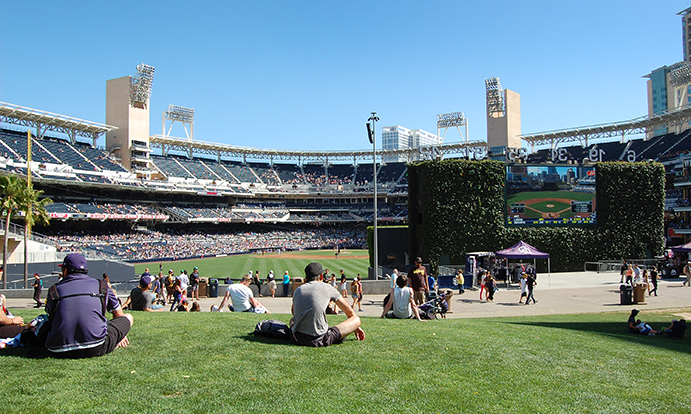
The meandering green expanse known as the Park at the Park allows fans to pay minimal ticket prices, spread out and enjoy the game—even as the obstructed views warrant a big screen to help follow the action.
Initially, the monster gaps became the best friend of the Padres and their pitching staff, which didn’t have to deal with the extra work and exhaust that, say, pitchers in high-altitude, high-scoring Coors Field in Denver had to confront. Fewer baserunners allowed meant fewer batters faced, which meant fewer pitches thrown, which meant less fatigue for the rotation and bullpen alike. That aided the Padres in the standings; in each of their first four seasons at Petco, they finished on the north side of .500 and twice reached the playoffs, once in 2005 with an 82-80 record that was somehow good enough to win the National League’s Western Division.
The fans certainly responded to the beauty of the new ballpark and the Padres’ winning attitude. Petco Park drew three million fans in its first season and almost that many over the next few to follow. That was a victory for a market that’s the majors’ fifth smallest with little regional pull beyond the adjacent suburbs. To the north, there was the Los Angeles Basin—claimed by the Angels and Dodgers. To the south, there was Tijuana—an obstacle course of a short drive for potential fans south of the border. To the east, there was desert and little else. To the west, the Pacific Ocean; rumor has it that fish are not baseball fans.
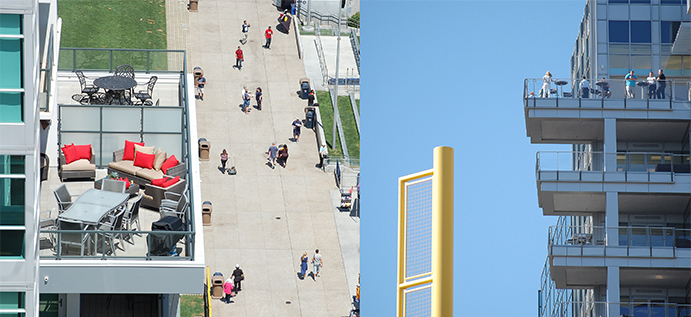
Hi-rise residential and business towers, built as part of the voter-approved Petco Park development, offer up the opportunity for those who occupy them to enjoy a birds-eye view of the game.
Despite the early successes on the field and at the gate, there would be the inevitable waning of the novelty factor that affects nearly every new ballpark—but compounding the problem was a failure to bring in free agent bashers who avoided Petco Park the way one equipped with garlic and a cross avoided Dracula. On the flip side, there was no flip side. The expected exodus of salivating star pitchers to San Diego never materialized because of the team’s unwillingness to bulk up its modest payroll. This has left the Padres as a working-class roster heavy on tireless gamers and a strong bullpen that benefits from the pitcher-friendly conditions—a state of affairs most humorously reflected by the San Diego Union-Tribune, which referred to Petco Park as “Miracle-Gro for relievers.” The beautiful city, the beautiful climate and the beautiful ballpark have simply not been enough to lure All-Star talent; for that class of players, baseball stats matter more than meteorological stats.
Finally, in 2013, the Padres said enough to the ballpark’s nonstop reputation as a pitcher’s haven. They brought in the fences. Ten feet was shaved off the voluminous gaps and the right-field wall was lowered, creating a brand new lounge area sponsored by Jack Daniels. It was hoped that the spark in offense would lead to a spark in attendance, which had dropped below two million on occasion. Neither happened. The gate remained static, and although home run totals increased, Petco Park was still out-homered by 21 of 29 other ballparks. Worse, batters hit just .237 and only three other ballparks witnessed fewer runs. The Padres themselves must have privately felt the reduction in field dimensions weren’t enough; maybe that’s why the distances to the gaps aren’t posted on the outfield walls.
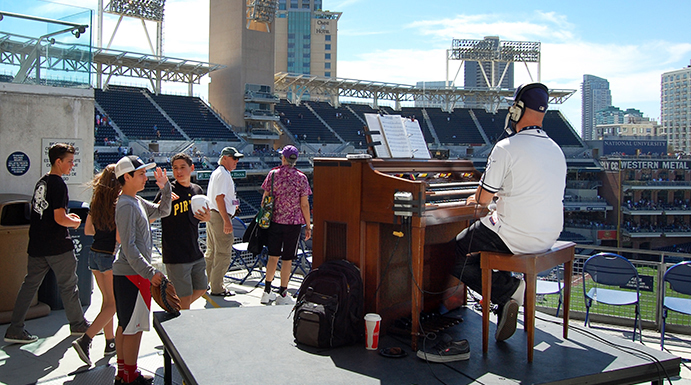
The threat of rain is so non-existent during the baseball season at Petco Park, even the ballpark’s organist plays outdoors.
Turning on the Gaslamp.
For many baseball fans, enjoying Petco Park is just half the fun. The other half can be found immediately outside the ballpark’s gates in San Diego’s historic Gaslamp Quarter, which has received a financial shot in the arm from the presence of Petco Park and the surrounding hotels and condo developments that have sprung up on its coattails. Few if any ballparks are accompanied with such active and entertaining surroundings.
Gaslamp is dominated by restaurants and bars that cater to fans before and after the game; the love is often returned from those looking for pregame and/or postgame fun, but to be safe the establishments do their best to maximize their exposure to the foot traffic, often positioning gorgeous young ladies at the sidewalk entrances to lobby passers-by to come in for a bite or drink. It’s a place for fans to watch and be watched; sidewalk dining and imbibing is a must as there’s little fear of inclement weather—after all, the Padres have only been rained out once in 10-plus years at Petco.
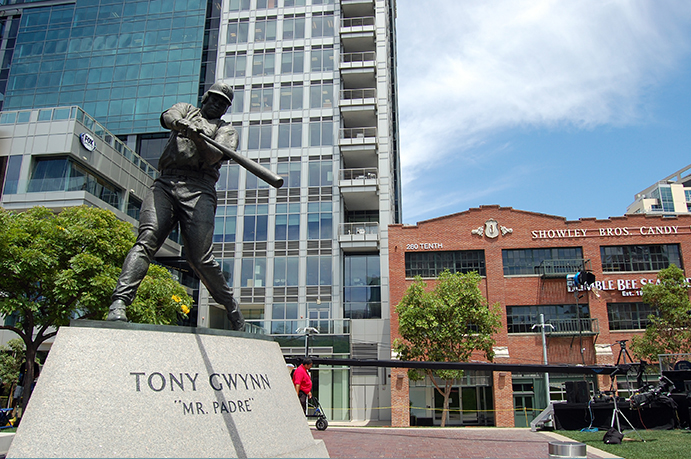
Located in the Park at the Park behind the outfield, the Tony Gwynn statue is surrounded by new business development and rescued historic landmarks. A week after this picture was taken, the base of the statue was flooded with flowers in the wake of Gwynn’s passing from cancer.
The combination of Petco Park and the Gaslamp Quarter is a powerful magnet not just for Padres fans, but for two other sets of folks: The newly arrived residents who have remade East Village, the eastern third of downtown, from a once derelict section of the city into a thriving, hip neighborhood, and out-of-town baseball fans—usually those of the Giants and Dodgers—who fly or drive in and flood Petco Park. The loss of a partisan element in the crowd may leave Padres players gnashing their teeth, but it certainly brings smiles and piles of extra dough to the merchants of Gaslamp, including the numerous hotels that have risen around the ballpark. Hotel Omni and Hotel Solamar are among the many that were erected as part of the surrounding redevelopment that accompanied Petco Park, and the Gaslamp Marriott, renovated in Petco’s inaugural 2004 season, sits cattycorner from the left field entrance and features a 22nd-story lounge that looks right down on the ballpark.
Petco Park may lack for offense on the field, but it’s a major hit off it. Its openness, its inviting nature and its proximity to all things San Diego has made it a primary attraction to kick back and enjoy a day at the ballpark. Or just the park. Or the beach. Or anyplace within its graceful confines that has something for everybody, San Diego-style.
 The Ballparks: Qualcomm Stadium Buffeted by giant corkscrew-style ramps and surrounded by a sea of parking, Qualcomm Stadium—originally named after the beautiful city that built it, followed by the fellow who championed it into being—could be confused for a modern-day fortress, especially in a town renowned for its military reputation. Yet for nearly 50 years it has shined as the beacon that lifted San Diego into the major leagues.
The Ballparks: Qualcomm Stadium Buffeted by giant corkscrew-style ramps and surrounded by a sea of parking, Qualcomm Stadium—originally named after the beautiful city that built it, followed by the fellow who championed it into being—could be confused for a modern-day fortress, especially in a town renowned for its military reputation. Yet for nearly 50 years it has shined as the beacon that lifted San Diego into the major leagues.
San Diego Padres Team History A decade-by-decade history of the Padres, the ballparks they’ve played in, and the four people who are on the franchise’s Mount Rushmore.


